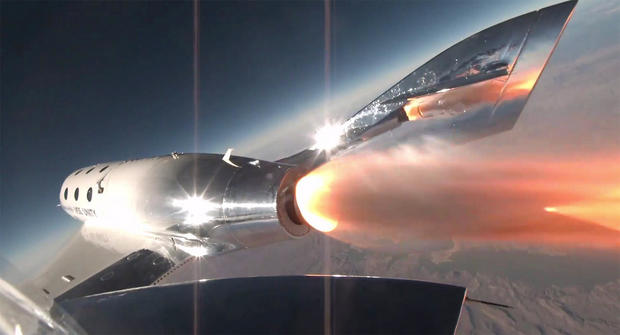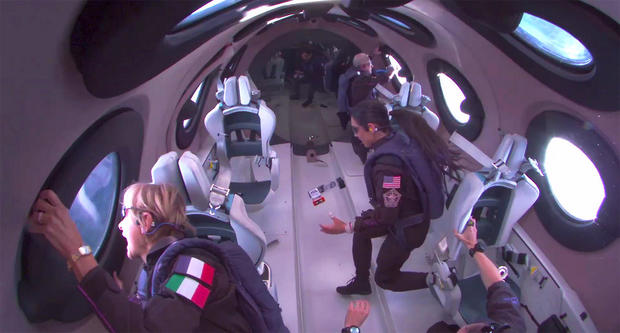Virgin Galactic launches fifth commercial flight to sub-orbital space and back
Planetary scientist Alan Stern, who spearheaded NASA's New Horizons mission to Pluto, enjoyed a spaceflight of his own Thursday, soaring to the edge of space and back aboard Virgin Galactic's winged spaceplane, chalking up the company's fifth commercial sub-orbital flight.
Stern, researcher and STEM "influencer" Kellie Gerardi, Italian investment manager Ketty Maisonrouge, two Virgin Galactic pilots and a company trainer were carried aloft by a carrier jet that released the Unity spaceplane at an altitude of about 44,700 feet above the New Mexico desert.
At the controls were Unity commander Michael Masucci and pilot Kelly Latimer, both veterans of earlier flights. Virgin astronaut trainer Colin Bennett joined the three passengers in Unity's multi-window cabin.
Seconds after release, Unity's hybrid rocket motor ignited with a rush of flame, propelling the ship up on a near-vertical trajectory, accelerating to nearly three times the speed of sound.
The motor then shut down and the crew enjoyed three to four minutes of weightlessness as Unity coasted up to an altitude of 54.2 miles — NASA recognizes 50 miles as the "boundary" between the discernible atmosphere and space — where it arced over and began the long fall back to Earth.
During their brief sojourn in weightlessness, Stern and Gerardi collected data with five experiments primarily focused on the physiological aspects of microgravity.
Stern wore a biomedical harness to monitor his body's reaction to weightlessness and planned to practice procedures with a high-tech camera that will be used on a future NASA astronomical research mission. Gerardi planned to operate three experiments related to microgravity healthcare and fluid dynamics.
A former chief of NASA's science division and principal investigator with the agency's New Horizons mission to Pluto, Stern was sponsored by the Southwest Research Institute where he now helps lead the space science division.
"Our objective in developing requirements, procedures timelines and training runs is to maximize the value of this first spaceflight and to minimize risks to performance on the second flight while doing NASA experiment work," Stern wrote before launch.
"And while there is always more one could do, I believe we have a solid plan both for flight ops and for training to perform those that's commensurate with the low cost of this mission. Of course, the proof of that will come at showtime, in space, high above southern New Mexico!"
Gerardi's trip was sponsored by the International Institute for Astronautical Sciences while her experiments were developed by the National Research Council of Canada. Maisonrouge is an investment manager who was born in Italy and grew up in Switzerland and France. She was among Virgin's first customers, reportedly paying $250,000 for a seat back in 2005.
As it began descending, Unity's two swept-back wings rotated upward, or "feathered," earlier in the flight, working as designed to properly orient the spacecraft, increase atmospheric drag and reduce the "loads" acting on the ship during re-entry.
Back in the lower atmosphere, the wings rotated back down parallel to the fuselage and the pilots guided the spaceplane, now flying as a glider, to touchdown on Spaceport America's 12,000-foot-long runway just west of the White Sands Missile Range at 11:59 a.m. EDT.
It was Unity's 10th piloted flight above an altitude of 50 miles and Virgin's fifth fully commercial flight in a row with paying customers aboard. Overall, Virgin Galactic has launched 49 company employees and commercial passengers in Unity's 10 sub-orbital flights to date.
Jeff Bezos' Blue Origin, which has launched six sub-orbital flights with 32 passengers using its more traditional New Shepard rocket and capsule, is currently in a standdown while resolving a booster problem that occurred during an unpiloted microgravity research flight last year.
Virgin Galactic's next flight is planned for January. Blue Origin is expected to resume New Shepard flights before the end of the year.






